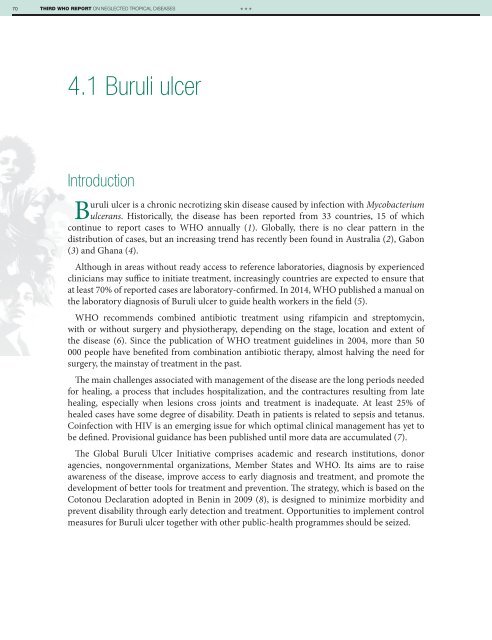1A9bnbK
1A9bnbK
1A9bnbK
You also want an ePaper? Increase the reach of your titles
YUMPU automatically turns print PDFs into web optimized ePapers that Google loves.
70 THIRD WHO REPORT ON NEGLECTED TROPICAL DISEASES<br />
***<br />
4.1 Buruli ulcer<br />
Introduction<br />
Buruli ulcer is a chronic necrotizing skin disease caused by infection with Mycobacterium<br />
ulcerans. Historically, the disease has been reported from 33 countries, 15 of which<br />
continue to report cases to WHO annually (1). Globally, there is no clear pattern in the<br />
distribution of cases, but an increasing trend has recently been found in Australia (2), Gabon<br />
(3) and Ghana (4).<br />
Although in areas without ready access to reference laboratories, diagnosis by experienced<br />
clinicians may suffice to initiate treatment, increasingly countries are expected to ensure that<br />
at least 70% of reported cases are laboratory-confirmed. In 2014, WHO published a manual on<br />
the laboratory diagnosis of Buruli ulcer to guide health workers in the field (5).<br />
WHO recommends combined antibiotic treatment using rifampicin and streptomycin,<br />
with or without surgery and physiotherapy, depending on the stage, location and extent of<br />
the disease (6). Since the publication of WHO treatment guidelines in 2004, more than 50<br />
000 people have benefited from combination antibiotic therapy, almost halving the need for<br />
surgery, the mainstay of treatment in the past.<br />
The main challenges associated with management of the disease are the long periods needed<br />
for healing, a process that includes hospitalization, and the contractures resulting from late<br />
healing, especially when lesions cross joints and treatment is inadequate. At least 25% of<br />
healed cases have some degree of disability. Death in patients is related to sepsis and tetanus.<br />
Coinfection with HIV is an emerging issue for which optimal clinical management has yet to<br />
be defined. Provisional guidance has been published until more data are accumulated (7).<br />
The Global Buruli Ulcer Initiative comprises academic and research institutions, donor<br />
agencies, nongovernmental organizations, Member States and WHO. Its aims are to raise<br />
awareness of the disease, improve access to early diagnosis and treatment, and promote the<br />
development of better tools for treatment and prevention. The strategy, which is based on the<br />
Cotonou Declaration adopted in Benin in 2009 (8), is designed to minimize morbidity and<br />
prevent disability through early detection and treatment. Opportunities to implement control<br />
measures for Buruli ulcer together with other public-health programmes should be seized.


